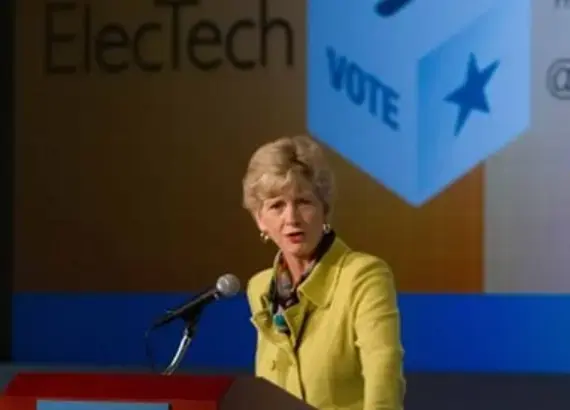
Success Story
Tech@State Explores How Technology Can Boost Confidence in Elections Worldwide
On the heels of the tech-focused U.S. presidential election, last week’s Tech@State conference brought together government agencies, nongovernmental organizations, private companies, academics and technologists to explore how technology is used in domestic and international elections.
“Running elections is all about public confidence,” said Missouri Secretary of State and NDI board member Robin Carnahan, keynote speaker at the Nov. 30 conference. “It’s about public confidence in the process and, therefore, the results.”
The gathering was devoted to exploring how technology can boost that confidence -- or undermine it. With examples from the campaigns of President Obama and former Governor Mitt Romney, as well as from Afghanistan, Estonia, Ghana, Kosovo, Nigeria and Uganda, participants learned how to use data more effectively in elections, mobile election technology, electronic voting, data visualizations such as maps and graphs, and audio and SMS tools for engaging citizens.
Tech@State was organized by the U.S. State Department in partnership with NDI. The George Washington University Law School, MetroStar Systems and Topsy were additional supporters.
Pat Merloe, NDI director of election programs, explained that inclusiveness, transparency and accountability remain the guiding principles for international elections.
NDI's "Unconference"
The ‘unconference’ held at NDI’s D.C. offices gave participants the chance to expand on topics discussed at Tech@State through a series of small collaborative sessions. Among the topics discussed in one-hour sessions were using data more effectively to understand election environments, how to use mobile technology to improve elections in closed environments and how technology can be used to amplify best practices for elections around the world. For instance, one session focused on how to use election data visualization to keep citizens informed about the voting process and election outcomes, using examples such as the election portal built by NDI partners in Georgia ahead of the Oct. 1 parliamentary elections that pulled together information on election observation and voting patterns for the public. Another session focused on how to ensure that citizen reporting is effectively during elections to report on issues such as incidences of violence or fraud.
Katrin Verclas, NDI’s innovation manager, noted that “there has been a surge of interest in using data effectively. We explored in a number of sessions how to tell the story of how an election went, such as using data visualizations, and using map layers of demographic information and citizen election reports. It’s a growing field with a lot of exciting innovations. NDI is definitely at the forefront of this work.”
Since 2006, NDI has pioneered the use of text messaging to quickly and accurately transmit critical incidence and election results data in real-time to make election data collection fast and accurate. More recently, NDI has explored ways to use technology to engage citizens in the pre-election period, such as in Burma and Nicaragua where citizens could report irregularities to sites like the Burma Election Tracker and Viva El Voto. And NDI is experimenting with using maps and overlays of historic election and demographic data to supplement real-time election information, providing comparisons between what is happening now in certain areas to voter attitudes in the past.
But while the use of technology can be a positive force in elections, good intentions are not always a given. Susan Hyde, an associate professor at Yale University who studies international election observation, pointed out that using technology to lower barriers is good, but it should be asked why those barriers are there in the first place. “Cruel and vicious autocrats can use and exploit data to do harm,” said Hyde.
“Data aggregation is different from data integration,” said Michael Slaby, chief innovation and integration officer at Obama for America. “Generally we are drowning in data and what we want is insight.” He explained the long and painstaking process of amassing all the data for the Obama campaign -- based on demographics, 2008 results, social media research, and new information gathered by campaign workers and volunteers -- and integrating it fully into all aspects of the campaign. His counterpart on the Romney campaign agreed. “Just as grassroots infrastructure must be built out ahead of time, so too must the data infrastructure,” said Matt Lira, digital director of the Romney campaign. “It can’t be ramped up at the last minute.”
Breakout sessions throughout the day and an “unconference” the following day allowed participants to dig into these shifting norms and collaborate on innovations for global elections. Participants had the opportunity to learn new ways of visualizing election data, when and how to use citizen reporting strategies and tools to engage citizens in the election process, as well as ways technology can help register voters, check their registration status, inform them about candidates and issues, and assist them in accessing the polls.
“This is not a fad, this is not trend. This the front edge of a movement,” said Andrew Rasiej, founder of the Personal Democracy Forum and the conference’s closing speaker. As more people around the world get smart phones and access to the global communications network, they will demand more inclusive and accountable democracies. “We are moving from the era of e-government to we-government,” he said.
Videos from the Tech@State event can be found here.
Related:
Published Dec. 6, 2012
